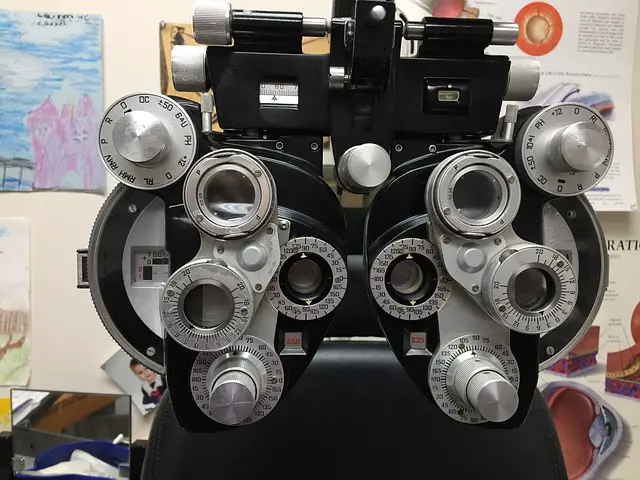Can People With Astigmatism Wear Contacts

Astigmatism is a common vision condition that causes blurred or distorted vision. People who have astigmatism may wonder if they can wear contact lenses to correct their vision. The good news is that contacts are available for people with astigmatism and can provide excellent vision correction. This article will provide an overview of what astigmatism is, how it affects vision and whether contact lenses are the right option for those with the condition.Yes, people with astigmatism can wear contact lenses. Depending on the degree of astigmatism, there are various types of contact lenses available to correct vision for those with this condition. Soft toric lenses and gas permeable lenses are two types of contact lenses that can be worn by people with astigmatism. It is important to consult an optometrist to get proper advice about which type is best suited for you.
Types of Contacts Available for People With Astigmatism
People suffering from astigmatism have several options when it comes to contact lenses. Depending on the severity of the condition, certain types of contacts may be more beneficial than others. Toric lenses are specially designed to correct astigmatism, as they have different powers in different meridians, allowing them to correct both astigmatic and near- or far-sighted vision. Soft lenses, which are made of soft, flexible plastics, are also widely available for those with astigmatism. Rigid gas permeable (RGP) lenses may also be used; they are usually less comfortable than soft lenses but offer better vision correction. Monovision contacts are also available for those with astigmatism; one lens is used to correct near-sightedness while the other is used to correct far-sightedness. Finally, hybrid contacts provide a combination of rigid and soft materials for greater comfort and improved vision correction.
No matter what type of contact lens is chosen, proper fitting by an optometrist is essential in order to ensure maximum comfort and vision correction. Additionally, regular eye exams should be performed in order to check for any changes in prescription or eye health issues that could affect contact lens wear.
What Is Astigmatism?
Astigmatism is an eye condition that causes blurred vision. It occurs when the cornea, or the front surface of the eye, is curved or has an irregular shape. This prevents light from focusing properly in the eye, resulting in blurred and distorted vision. Astigmatism can also cause headaches and eyestrain. It can occur with nearsightedness (myopia) or farsightedness (hyperopia).
Astigmatism affects people of all ages and usually requires corrective lenses to improve vision. Treatment typically includes eyeglasses, contact lenses, or refractive surgery. Eyeglasses are a common recommendation as they are simple to use and can correct both nearsightedness and astigmatism at the same time. Contact lenses can provide better vision than eyeglasses but require more maintenance. Refractive surgery such as LASIK reshapes the cornea, which improves your vision without glasses or contacts.
It’s important to have regular eye exams to check for astigmatism and other eye conditions. Early diagnosis and treatment are important for achieving clear vision and preventing other complications from developing.
Benefits of Contact Lenses for People With Astigmatism
Contact lenses are a great way to correct vision for those with astigmatism. They provide a comfortable, unobstructed view and are easy to wear and care for. The lenses are designed to fit the shape of the eye, making them more comfortable than glasses. They also offer the convenience of not having to worry about fogging up or slipping off during physical activity. Additionally, contact lenses allow people with astigmatism to enjoy activities like swimming and playing sports without having to worry about their prescription glasses getting in the way.
Contact lenses also offer benefits that go beyond just correcting vision. For example, contact lenses can reduce halos and glare associated with astigmatism, providing a clearer field of view. This can be especially beneficial when driving at night or participating in other activities where bright light might be an issue. Additionally, because they’re not bulky like glasses, contact lenses make it easier for people with astigmatism to wear sunglasses or hats without having their vision blocked.
Finally, contact lenses offer people with astigmatism the convenience of not having to worry about cleaning or storing their glasses. They can simply take out their contacts at the end of the day and throw them away; no need to worry about cleaning solutions or cases. Additionally, contacts make it easier to switch between different prescriptions as needed; if your prescription changes, you can just order new contacts instead of needing new glasses every time.
Overall, contact lenses offer many benefits for those with astigmatism that go beyond just correcting vision. From improved comfort and clarity of vision to convenience and ease-of-use, contacts are a great way for people with astigmatism to improve their quality of life.
Advantages of Contact Lenses for People With Astigmatism
Contact lenses offer several advantages for people with astigmatism. One of the biggest advantages is that contact lenses can provide clearer vision than eyeglasses, as they can correct astigmatism more effectively by changing the shape of the eye. This is due to the fact that contact lenses are designed to fit closer to the eye, so they can be more effective at correcting vision problems. Additionally, contact lenses are a great choice for people who have active lifestyles and don’t want to be hindered by wearing glasses. Contact lenses provide an unobstructed field of view, which is especially beneficial if you play sports or participate in other activities that require clear vision. Furthermore, contact lenses are much more discreet than eyeglasses, allowing you to keep your look natural and stylish.
Disadvantages of Contact Lenses for People With Astigmatism
While contact lenses offer many benefits for people with astigmatism, there are also some drawbacks. For one, they require regular cleaning and maintenance in order to prevent infections and other complications. Additionally, due to their size and shape, it can be difficult to get used to wearing them and some people find them uncomfortable or irritating. Furthermore, contact lenses can be expensive when compared with eyeglasses and may not be covered by insurance plans. Finally, if not worn properly or cleaned regularly, contact lenses can cause damage to the cornea and other parts of the eye. For these reasons it’s important to consult your optometrist before deciding whether or not contact lenses are right for you.

Different Types of Contact Lenses for People With Astigmatism
Contact lenses are a great way for people with astigmatism to correct their vision. There are several different types of contact lenses that can help improve vision and reduce the symptoms of astigmatism. The most common type of contact lens for astigmatism is a toric lens. Toric lenses are designed to correct astigmatism by reshaping the cornea, allowing light to focus more accurately on the retina. Toric lenses come in both soft and hard varieties, and they come in a variety of base curves and diameters to fit different eye shapes.
Another type of contact lens for people with astigmatism is a hybrid lens. Hybrid lenses combine the benefits of both soft and hard lenses, providing comfort as well as superior vision correction. They also tend to be more durable than other types of contact lenses, making them a good choice for active lifestyles. Hybrid lenses come in both spherical and toric varieties, so they can be used to correct both nearsightedness and astigmatism.
Multifocal contact lenses are designed to correct both nearsightedness and farsightedness, as well as presbyopia (age-related difficulty focusing up close). These lenses have two or more prescription powers that focus light on different parts of the retina, allowing the wearer to see clearly at all distances. They are available in both soft and hard varieties, but they tend to be more expensive than other types of contact lenses due to their complexity.
Finally, there are scleral contacts lenses, which are custom-made rigid gas permeable (RGP) contacts that sit on the white part (sclera) of your eye instead of directly on your cornea like other contacts do. These lenses provide superior vision correction for even severe levels of astigmatism, but they can take some getting used to since they cover a larger area than other types of contacts do.
No matter what type of contact lens you choose, it’s important to have regular checkups with an optometrist or ophthalmologist so that your prescription can be adjusted if necessary and any problems can be identified early on. With proper care and maintenance, you can enjoy clearer vision with less distortion from your astigmatism using the right type of contact lens for your eyes!
How to Choose a Pair of Contacts for People With Astigmatism
People with astigmatism may have difficulty finding a pair of contacts that fit them perfectly. It is important to find the right type of contacts that provide comfort and clear vision. Here are some tips for choosing contacts for people with astigmatism:
First, it is important to visit your eye doctor and get a prescription for contact lenses specifically designed for astigmatism. This will ensure that the lenses are the correct size and shape for your eyes. Your doctor may also recommend certain types of lenses that are best suited to your condition.
Second, when shopping for contacts, make sure to look for those made from silicone hydrogel. These materials allow more oxygen to reach your eyes and keep them healthy, which is especially important if you have astigmatism. They also tend to be more comfortable than other types of contacts.
Third, consider using toric lenses if you have astigmatism. These lenses have an additional curvature along the vertical axis that helps counteract the blurriness caused by astigmatism. The design of toric lenses also helps them stay in place on your eyes better than regular soft contacts do.
Fourth, ask your eye doctor about special coatings or tints that can be applied to your contact lenses. These can help reduce glare and sharpen vision, which can be beneficial if you have astigmatism.
Finally, make sure you follow the instructions provided by your eye doctor when putting in and taking out your contact lenses. Wearing contacts improperly can lead to discomfort or even damage to your eyes, so it is important to follow all safety guidelines when handling them.
By following these tips, you can find a pair of contacts that fit properly and provide clear vision no matter what type of astigmatism you have.
Caring for Contacts
Caring for contacts is an important part of owning and wearing them. It’s important to keep your contacts clean and properly maintained in order to ensure optimal vision and comfort. People with astigmatism must be especially mindful of their contact care, as any dirt or debris can cause discomfort and even damage the contact lens. To ensure the best care for your contacts, it’s important to take a few simple steps:
Wash Your Hands
Before handling your contacts, make sure you wash your hands thoroughly with soap and water. This removes any dirt, bacteria, or oils that could be transferred from your hands to the contacts. Dry your hands with a lint-free towel before handling the lenses.
Clean Your Contacts
Use a contact lens solution specifically designed for cleaning soft lenses. Place each contact into the palm of your hand and add a few drops of solution directly onto the lens. Rub both sides of the lens gently between your index finger and thumb for about twenty seconds, then rinse each side with solution before storing in a clean contact lens case filled with fresh solution.
Replace Contact Lens Solution
It’s important to replace contact lens solution at least once a week in order to prevent bacteria growth on the lenses. Always use new solution when storing your contacts overnight or for extended periods of time during the day. Never reuse old solution as this can increase the risk of infection or irritation from contaminants in used solution.
Replace Contacts Regularly
It’s important to replace contacts according to manufacturer guidelines in order to ensure proper vision and comfort while wearing them. People with astigmatism should follow their doctor’s recommendations on how often they need to replace their contacts; this may be more often than those without astigmatism due to increased sensitivity of these lenses.

Conclusion
Yes, people with astigmatism can wear contacts. They can choose from a variety of contact lenses designed specifically for astigmatism, including toric lenses and hybrid lenses. These lenses are designed to help correct vision problems associated with astigmatism. However, it is important to note that contact lenses may not be the best choice for everyone with astigmatism. Individuals should consult with their eye care professional to determine the best option for their individual needs. With the right type of lens, people with astigmatism can enjoy clear vision and improved comfort when wearing contacts.
In conclusion, contact lenses are an excellent choice for individuals with astigmatism who want to improve their vision without the hassle of glasses. With so many types of lenses available, there is sure to be an option that fits your needs and lifestyle. Talk to your eye care provider about the best contact lens option for you today!
